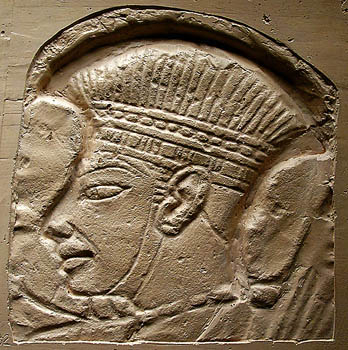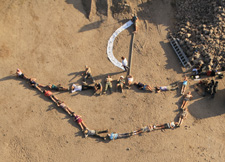The 'Sea Peoples'
 The 'Sea Peoples' is a collective name for groups of
rovers who ravaged the eastern Mediterranean during these troubled years. Ramesses III,
who thwarted their advance upon Egypt in 1174 BCE, had this victory immortalized in
an artistic and literary form:
The 'Sea Peoples' is a collective name for groups of
rovers who ravaged the eastern Mediterranean during these troubled years. Ramesses III,
who thwarted their advance upon Egypt in 1174 BCE, had this victory immortalized in
an artistic and literary form:
"The foreigners made a conspiracy in their island ... their confederation ware Plst, Skl,
Shklsh, Dnn and Wshsh united. No land could stand before them. Hatti [E. Anatolia],
Kode, Carchemish [N. Syria], Arzawa [W. Anatolia] and Alasia [Cyprus] ... were desolated
... they were coming towards Egypt, and fire walked before them."
It has long been generally accepted that the Plst are the biblical Philistines, but who are the other 'Sea Peoples'? Achaean heroes drifting east following the sack of Troy? Mycenaean refugees on the quest for a new homeland after the Dorian invasion? Rogue Egyptian mercenaries? Hakka-like 'boat-gypsies' scrapping a living from fishing, small-time trade and piracy? Do the names SKL and SHRDN imply that these peoples came from Sicily and Sardinia? Or perhaps that they settled there after their wanderings? Could the DNN be the biblical tribe of Dan? Or are they Homer's Danaoei? All these (and other) theories have been offered, at one time or another.
 There is only one definitive historical reference to the settlement of "Sea Peoples"
other than the Philistines along the Levantine littoral. The Egyptian "Story of Wen
Amon" narrates that Bdr, king of the SKL, resided at Dor c. 1080 BCE, and commanded a
fleet which ranged the Mediterranean from Egypt to north Syria and to Cyprus. Clearly,
the material culture of the relevant strata, as revealed at Dor, is the key to the
nature of the SKL and perhaps to the understanding of the entire 'Sea Peoples'
phenomenon.
There is only one definitive historical reference to the settlement of "Sea Peoples"
other than the Philistines along the Levantine littoral. The Egyptian "Story of Wen
Amon" narrates that Bdr, king of the SKL, resided at Dor c. 1080 BCE, and commanded a
fleet which ranged the Mediterranean from Egypt to north Syria and to Cyprus. Clearly,
the material culture of the relevant strata, as revealed at Dor, is the key to the
nature of the SKL and perhaps to the understanding of the entire 'Sea Peoples'
phenomenon.
Having reached a modest exposure of the relevant horizons in two excavation areas (soon to be matched by a third), the Tel Dor excavators have no simple answer to this question. On the one hand, it has been shown that Dor enjoyed a vibrant urban civilization -- which included the building of massive fortifications -- in an era otherwise noted for urban decline. Some unique artifacts attesting to "western connection" have been found, as well as a wealth of Egyptian imports. On the other hand, the bulk of the finds (especially the pottery) indicate a gradual evolution of the local material culture from Bronze Age Canaanite to Iron Age Phoenician, rather than a sudden influx of new populations.
